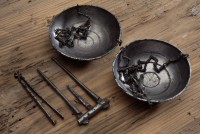 An archaeological excavation on the site of a highway expansion in the central Norwegian municipality of Steinkjer discovered two ship burials with grave goods that suggest the area may have been an important center of trade in the Viking era. Even though the artifacts are small clues, they are disproportionately important because they are direct evidence supporting the Norse sagas which describe Steinkjer as a major trading capital.
An archaeological excavation on the site of a highway expansion in the central Norwegian municipality of Steinkjer discovered two ship burials with grave goods that suggest the area may have been an important center of trade in the Viking era. Even though the artifacts are small clues, they are disproportionately important because they are direct evidence supporting the Norse sagas which describe Steinkjer as a major trading capital.
Steinkjer is ideally located for trade, at the head of the Beitstadfjorden fjord with the Atlantic on the west side, the Steinkjerelva river on the east and rich farmland all around. The village of Maere within the modern municipality was a religious center where people would assemble for seasonal celebrations and to perform ceremonial sacrifices to the Norse gods. Trondheim (Nidaros in Viking times), the capital of Norway from the 10th century to the 13th, is 75 miles to the south.
It’s a large area, however, and the coast line has changed a great deal since the saga heroes roamed the land. Add to that the difficulty of finding archaeological remains of organic trade goods and of deliberately impermanent structures, and archaeologists have had to rely on meager material like coins and other objects that were clearly imported to try to sort out where the trading center may have been. They plot the find sites of various traded artifacts on a map and then mark the areas with the highest concentration of goods as the likely trading spots. The distribution of amber and glass beads, Viking H swords and imported jewelry is heavily weighted towards Steinkjer.
What the two recently discovered ship burials added to the picture were two artifacts of particular relevance.
One, a silver button made of braided silver threads that appears to have originated in the British Isles, suggests that the person in the grave had a high status.
The second is a set of balance scales found in another boat grave. The balance scales were constructed in a way that led the archaeologists to believe it came from the west – not from Norway.
Scales themselves naturally suggest trade, and when the researchers looked at all the scales found in Nord-Trøndelag, they again found a clear concentration in the Steinkjer area.
So if Steinkjer was the center of trade described in the Norse sagas, where exactly was the tradepost? The working hypothesis right now is that it was under the current church. It’s the high point and sea levels were 15 or so feet higher on this coastline in 1000 A.D. than they are today, so it makes sense that the church site is where Norse traders did their trading. That’s going to stay a hypothesis for the time being since nobody’s going to be digging under that church anytime soon.
At some point in the Middle Ages, Steinkjer’s influence waned, probably because competing rulers moved their business elsewhere. Trondheim and other cities took over and Steinkjer became a sleepy fishing and agricultural area. It didn’t even get official town status until 1857.